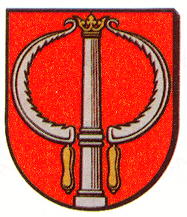Sichelnstein: Difference between revisions
Jump to navigation
Jump to search
Knorrepoes (talk | contribs) No edit summary |
Knorrepoes (talk | contribs) m (Text replace - "[[Literature" to "{{media}} [[Literature") |
||
| Line 19: | Line 19: | ||
====Origin/meaning==== | ====Origin/meaning==== | ||
The arms are canting, showing two sickles (Sicheln) and a pillar ('stein' or stone). The arms were granted by the Dukes of Braunschweig-Lüneburg in the late 18<sup>th</sup> century. The arms were also used by the Amt Münden and later by the Amt Sichelnstein (1830-1973). | The arms are canting, showing two sickles (Sicheln) and a pillar ('stein' or stone). The arms were granted by the Dukes of Braunschweig-Lüneburg in the late 18<sup>th</sup> century. The arms were also used by the Amt Münden and later by the Amt Sichelnstein (1830-1973). | ||
{{media}} | |||
[[Literature]] : Information provided by the [http://www.staufenberg-nds.de Staufenberg_council]. | [[Literature]] : Information provided by the [http://www.staufenberg-nds.de Staufenberg_council]. | ||
Revision as of 06:02, 9 July 2014
| Heraldry of the World Civic heraldry of Germany - Deutsche Wappen (Gemeindewappen/Kreiswappen) |
SICHELNSTEIN
State : Niedersachsen
District (Kreis) : Göttingen
Incorporated into : 1973 Staufenberg
Official blazon
Origin/meaning
The arms are canting, showing two sickles (Sicheln) and a pillar ('stein' or stone). The arms were granted by the Dukes of Braunschweig-Lüneburg in the late 18th century. The arms were also used by the Amt Münden and later by the Amt Sichelnstein (1830-1973).
Contact and Support
Partners:
Your logo here ?
Contact us
© since 1995, Heraldry of the World, Ralf Hartemink 
Index of the site
Literature : Information provided by the Staufenberg_council.











